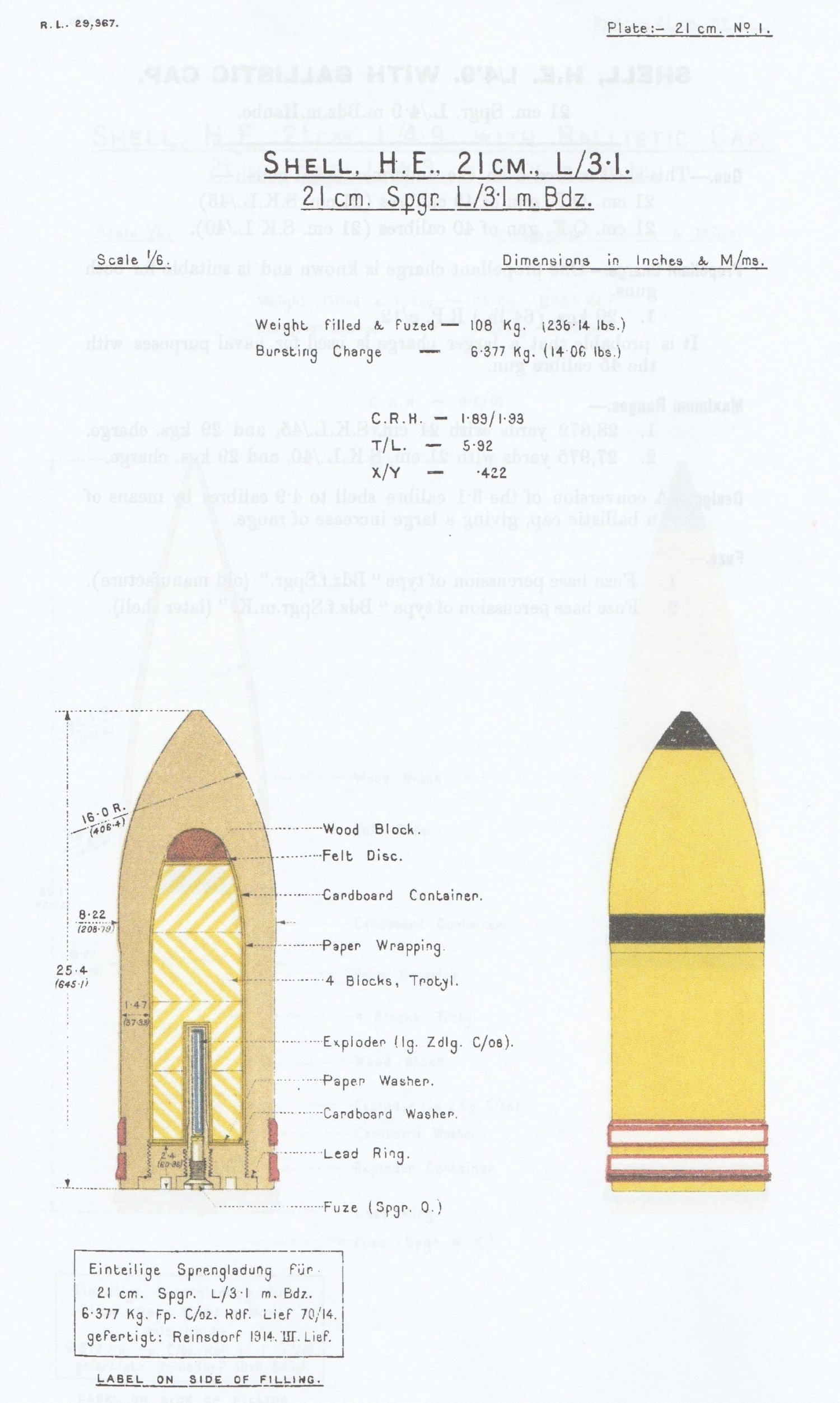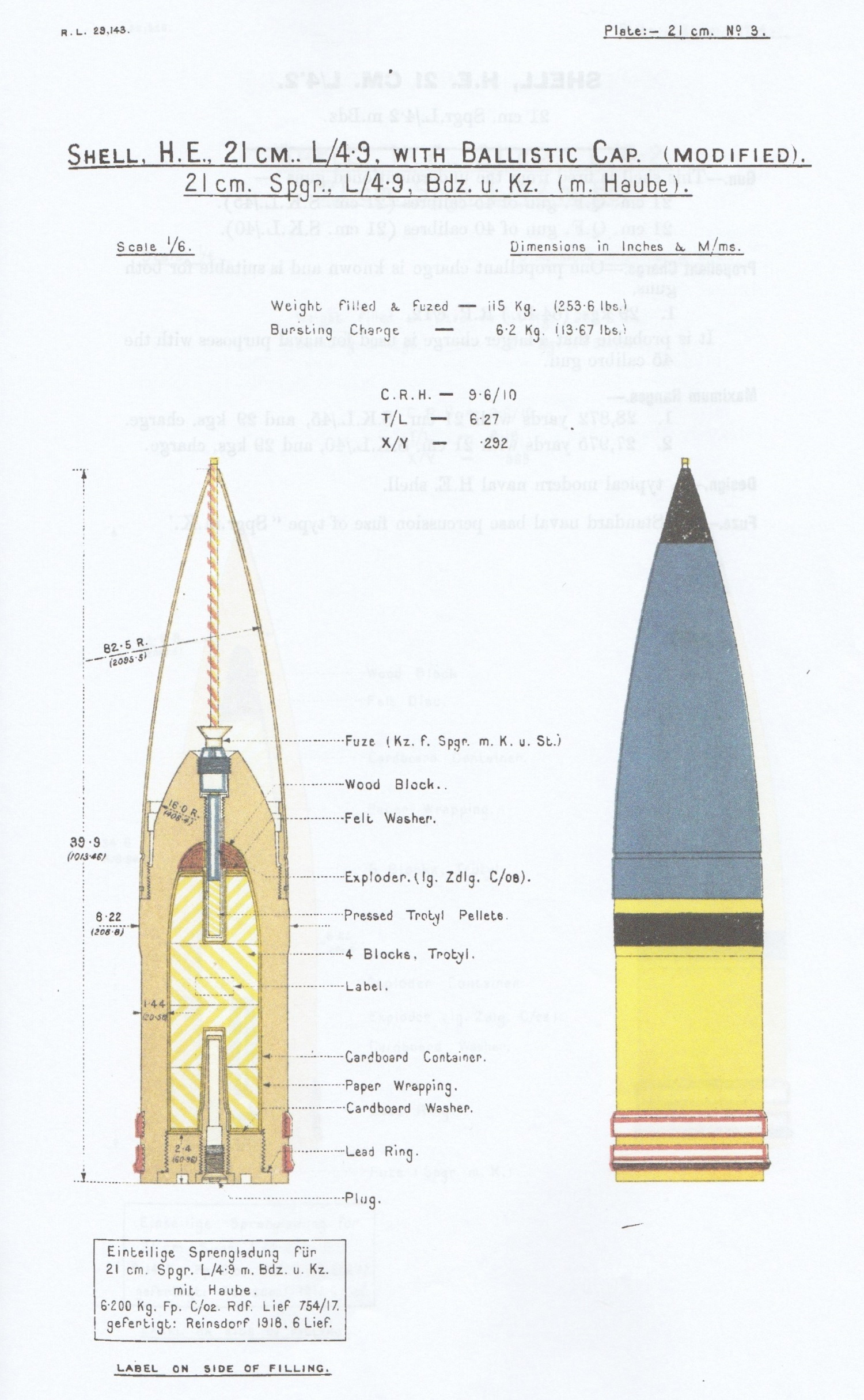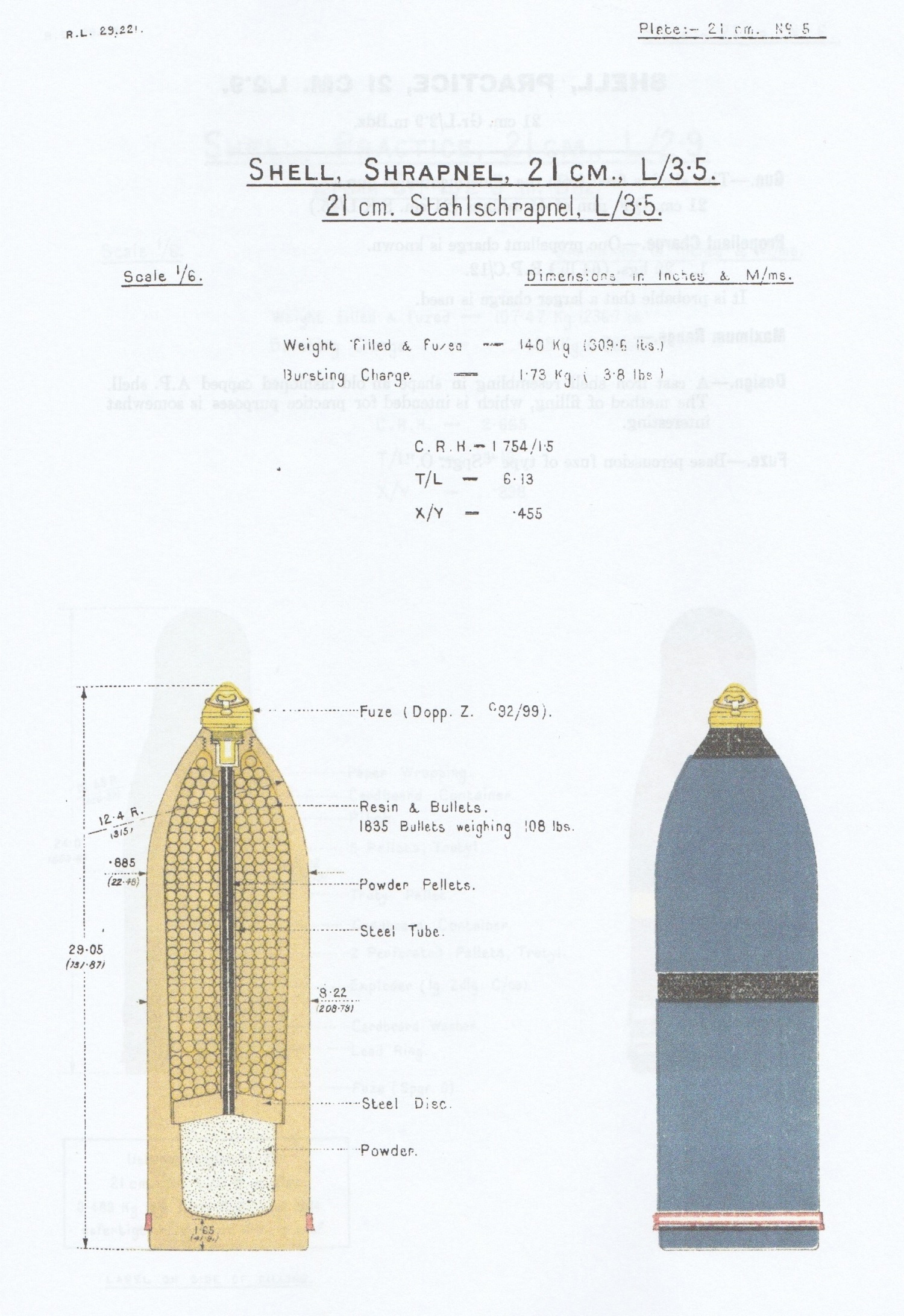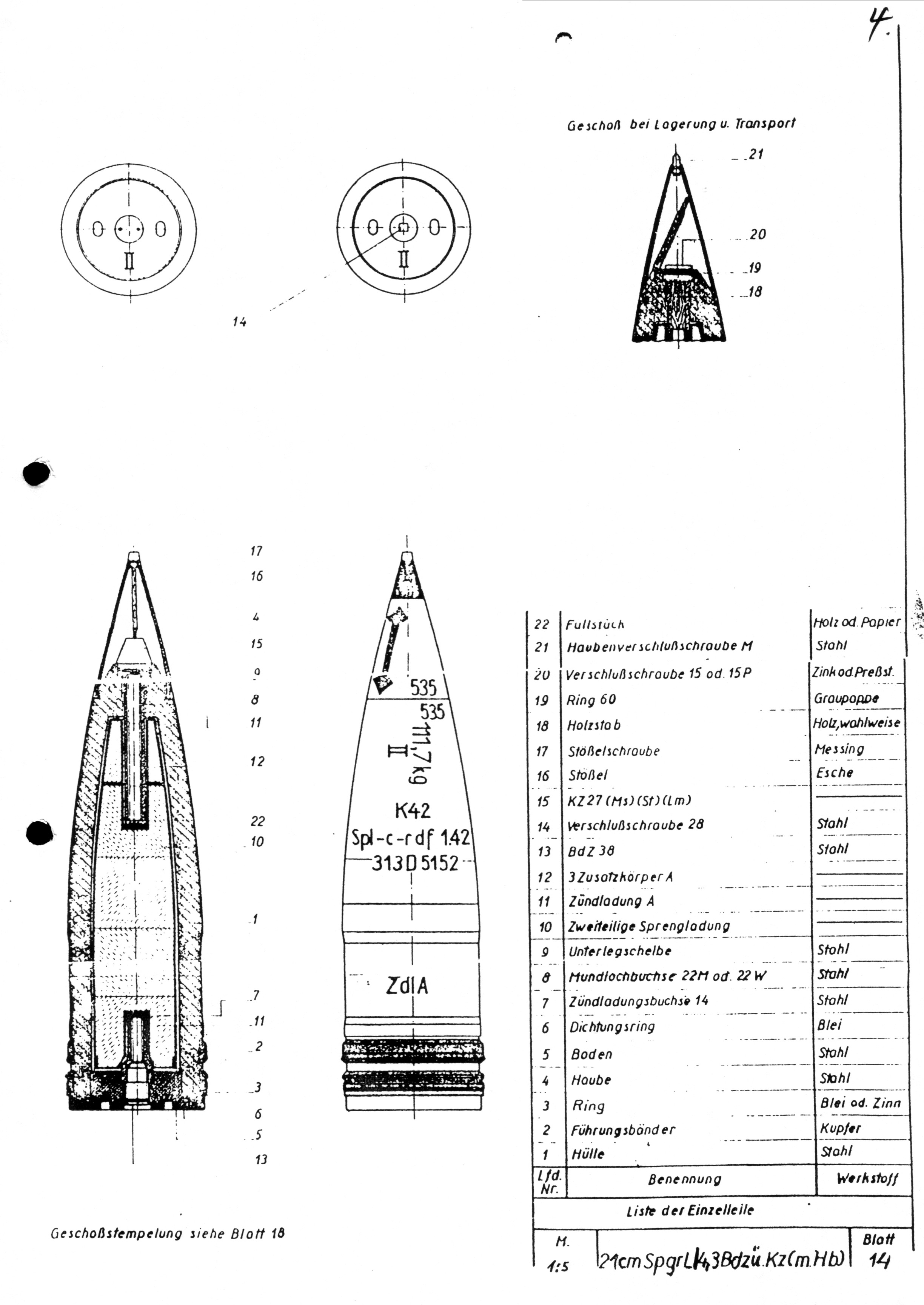
Used afloat only on the Armored Cruiser Blücher which was sunk at the World War I battle of Dogger Bank. After her sinking, four reserve guns were given to the German Army. During World War II these guns were being used in Coastal Defence batteries.
Constructed of A tube, two layers of hoops and a jacket. Used the Krupp horizontal sliding wedge breech block. 16 guns were made.
Actual bore diameter was 20.93 cm (8.24").
| Designation | 21 cm/45 (8.27") SK L/45 |
|---|---|
| Ship Class Used On | Blücher |
| Date Of Design | about 1905 |
| Date In Service | 1909 |
| Gun Weight | 16,156 lbs. (16,400 kg) |
| Gun Length oa | 370.9 in (9.420 m) |
| Bore Length | 347.5 in (8.826 m) |
| Rifling Length | 292.5 in (7.430 m) |
| Grooves | (60) 0.79 in D x 0.266 in W (2.0 mm D x 6.76 mm W) |
| Lands | 0.165 in (4.2 mm) |
| Twist | Increasing RH 1 in 45 to 1 in 30 at the muzzle |
| Chamber Volume | 3,033 in3 (49.7 dm3) |
| Rate Of Fire | 4 - 6 rounds per minute |
| Type | Separate |
|---|---|
| Projectile Types and Weights 1 | World War I - Blücher
AP L/2,9: 237.4 lbs. (107.7 kg) 2 HE L/3,1 base fuze: 237.4 lbs. (107.7 kg) 3 World War I - Coastal Artillery 4 5 World War II
|
| Bursting Charge | World War I 8 AP L/2,9: 6.93 lbs. (3.145 kg) TNT HE L/3,1 base fuze: 14.06 lbs. (6.377 kg) TNT HE L/4,2 base fuze: 17.95 lbs. (8.14 kg) TNT HE L/4,9 base fuze: 14.06 lbs. (6.377 kg) TNT HE L/4,9 base and nose fuze: 14.06 lbs. (6.2 kg) TNT 9 Shrapnel L/3,5: 1,835 spherical bullets and pitch weighing 108.0 lbs. (50.0 kg) World War II 10 |
| Projectile Length | AP L/2,9: 24.0 in (61 cm)
HE L/3,1 base fuze: 25.6 in (65 cm) HE L/4,2 base fuze: 34.6 in (87.9 cm) HE L/4,9 base fuze: 40.1 in (101.9 cm) HE L/4,9 base and nose fuze: 39.9 in (101.3 cm) Shrapnel L/3,5: 28.17 in (71.4 cm) HE L/4,3 base and nose fuze: 35.5 in (90 cm) |
| Propellant Charge 13 | Pre-World War I
Total Fore and Rear charges: 77.3 lbs. (35.1 kg) RP C/06 World War I
World War II
|
| Cartridge Case Type, Size and Empty Weight | Brass, 210 x 836 mm, N/A 14 |
| Muzzle Velocity | 2,953 fps (900 mps) |
| Working Pressure | 20.2 tons/in2 (3,175 kg/cm2) |
| Approximate Barrel Life | N/A |
| Ammunition stowage per gun | 85 rounds |
- ^
Actual designations for Projectiles AP L/2,9 21 cm Psgr. L/2,9 HE L/3,1 base fuze 21 cm Spgr. L/3,1 Bdz. Coastal HE L/4,2 base fuze 21 cm Spgr. L/4,2 Bdz. Coastal HE L/4,9 base fuze 21 cm Spgr. L/4,9 Bdz. (mhb) Coastal HE L/4,9 base and nose fuze 21 cm Spgr. L/4,9 Bdz. u. Kz. (mhb) Coastal Shrapnel L/3,5 21 cm Stahlschrapnel L/3,5 Coastal HE L/4,3 base and nose fuze 21 cm Spgr. L/4,3 Bdz u. Kz (m.Hb) - ^The HE L/3,1 base fuze projectile was apparently not in use during World War II as it is not included in M.Dv. Nr. 190,1A3.
- ^Most if not all of the Coastal Artillery projectiles were also used by the older 21 cm/40 SK L/40 guns used in Coastal Batteries.
- ^It would appear that none of the World War I coastal artillery projectiles were in service during World War II as they are not included in M.Dv. Nr. 190,1A3.
- ^The World War II HE L/4,3 round was a special coastal artillery projectile with both base and nose fuzes. This round had a ballistic cap and the same fuze rod as used in nose fuzed HE with ballistic caps. See sketch below.
- ^Burster weights for World War I projectiles from "Diagrams of Great War" and from M.Dv. Nr. 198.
- ^The HE L/4,9 base and nose fuze projectile had a slightly smaller burster than the HE L/3,1 base fuze from which it was made because some of the explosive had to be removed to accommodate the added nose fuze.
- ^Burster weights (reiner Sprengstoff) for World War II projectiles from M.Dv. Nr. 198.
- ^The burster for the APC L/2,9 projectile was made from Fp 15 and Fp 1.
- ^M.Dv. Nr. 198 gives two burster weights for HE L/4,3 base and nose fuze shell. This is related to the way that the bursters were packaged in the cavity. Both weights are included here for reference. Both bursters were made from Fp 1.
- ^These guns, like most large caliber German guns of this era, used a "fore charge" which was propellant in a double bag silk case and a "rear charge" which was propellant in a brass case. The brass case helped to seal the breech of the gun.
- ^The cartridge rim diameter was 243,2 mm.
| Elevation | Distance |
|---|---|
| 30 degrees
(Max. elevation of turret) |
20,900 yards (19,100 m) |
| Projectile | Range with Full Charge |
|---|---|
| HE L/3,1 base fuze | 20,450 yards (18,700) |
| Coastal HE L/4,2 base fuze | 28,870 yards (26,400 m) |
| Coastal HE L/4,9 base fuze | 28,870 yards (26,400 m) |
| Coastal HE L/4,9 base and nose fuze | 28,870 yards (26,400 m) |
| Coastal Shrapnel L/4,3 | N/A |
| Coastal HE L/4,3 base and nose fuze | N/A |
| Designation | Two-gun turrets
Blücher (6): DrL C/06 |
|---|---|
| Weight | 195 to 197 tons (198 to 200 mt) |
| Elevation | -5 / +30 degrees |
| Elevation Rate | 4 degrees per second |
| Train | Forward and Aft Turrets: about -150 / +150 degrees
Beam Turrets: about +30 / +150 degrees |
| Train Rate | 3.5 degrees per second |
| Gun recoil | 20.5 in (52 cm) |
- All but the forward wing turrets fed from common projectile/propellant ammunition magazines with two fixed hoists passing projectiles and main charges to a handling room below the gunhouse. Forward wing turrets differed from the other turrets in that they were fed from the ammunition spaces located beneath the rear wing turret via a centerline conveyor belt. This fed the wing turret handling rooms via inclined hoists, one for projectiles and one for main charges.
- Fore charges were passed into the handling room through openings in the barbette. Upper hoists revolved with the gunhouse. Each gun had a single hoist which fed both projectiles and main charges to the gun while the fore charge was supplied by auxiliary hoists located between the main hoists.
- The working chamber held ready ammunition, storing either 38 APC or 34 HE, 26 main and 52 fore charges. These allowed the guns to fire at about six rounds per minute until these were used up. Afterwards, the ROF was about 4 to 5 rounds per minute.
- Guns were individually sleeved, but could be coupled together.
- Gun axes were 70.9 in (180 cm) apart.
Armor thickness given in "Naval Weapons of World War One" Face 7.1 in (18 cm) Sides 5.5 in (14 cm) Rear 6.2 in (15.8 cm) Roof 2.4 to 3.1 in (6 to 8 cm)








"Naval Weapons of World War Two" by John Campbell
"Naval Weapons of World War One" by Norman Friedman
"German Warships 1815-1945" by Erich Gröner
"German Warships of World War I" by John C. Taylor
---
"Diagrams of Great War - German Naval Guns; Shells & Explosives; Fuses & Exploders" by The Royal Laboratory Woolwich 1921-22
"Munitionsvorschriften für die Kriegsmarine - Panzersprenggranaten (Psgr)" M.Dv. Nr. 190,1A2 by Oberkommando der Kriegsmarine
"Munitionsvorschriften für die Kriegsmarine - Sprenggranaten (Spgr)" M.Dv. Nr. 190,1A3 by Oberkommando der Kriegsmarine
"Munitionsvorschriften für die Kriegsmarine - Hülsenkartusche" M.Dv. Nr. 190,4A1 by Oberkommando der Kriegsmarine
"Übersicht über die für die Marinegeschütze und deren Abk K zu verwendende Munition und ihre Einzelteile einschließlich Salut-
und Manöverladungen" M.Dv. Nr. 198 by Oberkommando der Kriegsmarine
---
Special help from Thorsten Wahl
---
Tony DiGiulian's Personal Data Files
29 February 2008 - Benchmark
28 March 2010 - Added side view of WNGER_827-45_skc05
22 May 2012 - Updated to latest template
25 November 2012 - Added details about guns, ammunition and mountings
06 June 2015 - Added weights of main and fore charges, minor other changes
19 February 2019 - Converted to HTML 5 format, reorganized notes, added ammunition information from M.Dv. Nr. 190,1A2 and M.Dv. Nr. 190,1A3
18 November 2022 - Added information and sketches on World War I coastal artillery projectiles
30 August 2024 - Added burster notes and propellant information
